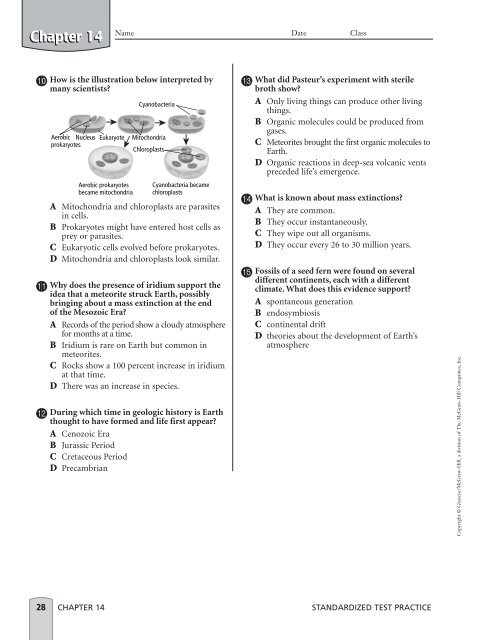biostp.2
biostp.2
biostp.2
Create successful ePaper yourself
Turn your PDF publications into a flip-book with our unique Google optimized e-Paper software.
Chapter 14<br />
Name Date Class<br />
bk<br />
How is the illustration below interpreted by<br />
many scientists<br />
Aerobic Nucleus Eukaryote<br />
prokaryotes<br />
Aerobic prokaryotes<br />
became mitochondria<br />
Cyanobacteria<br />
Mitochondria<br />
Chloroplasts<br />
Cyanobacteria became<br />
chloroplasts<br />
A Mitochondria and chloroplasts are parasites<br />
in cells.<br />
B Prokaryotes might have entered host cells as<br />
prey or parasites.<br />
C Eukaryotic cells evolved before prokaryotes.<br />
D Mitochondria and chloroplasts look similar.<br />
bl<br />
Why does the presence of iridium support the<br />
idea that a meteorite struck Earth, possibly<br />
bringing about a mass extinction at the end<br />
of the Mesozoic Era<br />
A Records of the period show a cloudy atmosphere<br />
for months at a time.<br />
B Iridium is rare on Earth but common in<br />
meteorites.<br />
C Rocks show a 100 percent increase in iridium<br />
at that time.<br />
D There was an increase in species.<br />
bm<br />
During which time in geologic history is Earth<br />
thought to have formed and life first appear<br />
A Cenozoic Era<br />
B Jurassic Period<br />
C Cretaceous Period<br />
D Precambrian<br />
bn<br />
What did Pasteur’s experiment with sterile<br />
broth show<br />
A Only living things can produce other living<br />
things.<br />
B Organic molecules could be produced from<br />
gases.<br />
C Meteorites brought the first organic molecules to<br />
Earth.<br />
D Organic reactions in deep-sea volcanic vents<br />
preceded life’s emergence.<br />
bo<br />
What is known about mass extinctions<br />
A They are common.<br />
B They occur instantaneously.<br />
C They wipe out all organisms.<br />
D They occur every 26 to 30 million years.<br />
bp<br />
Fossils of a seed fern were found on several<br />
different continents, each with a different<br />
climate. What does this evidence support<br />
A spontaneous generation<br />
B endosymbiosis<br />
C continental drift<br />
D theories about the development of Earth’s<br />
atmosphere<br />
Copyright © Glencoe/McGraw-Hill, a division of The McGraw-Hill Companies, Inc.<br />
28 CHAPTER 14 STANDARDIZED TEST PRACTICE


